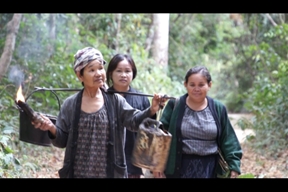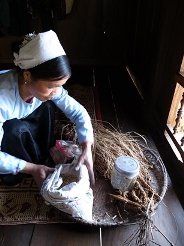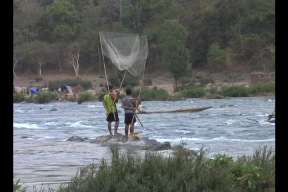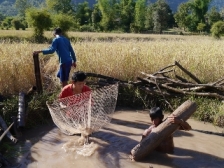
経済指標には反映されませんが、メコン河流域で暮らす人びとにとって価値のある自然と、その中で生きる人びとの生業などを可視化するため、流域の農山村における自然資源利用のあり方や人びとの取り組み、開発の影響を映像にまとめました。ラオスの森林の多様性と人びとの資源利用と開発の影響、持続的な農業のための山間地での農作物の多様性を維持するベトナムでの取り組み、人びとの河川利用とダム開発の影響が見てとれるタイの事例、そして、ラオスの少数民族があみ出した水田での養魚の方法を、それぞれ10分から20分の映像で紹介しています。伝えたい内容は、BPと重複する部分も多いですが、映像を活用することで、理解をより深めていただけるとありがたいです。
トランジション―ラオス 森の変遷と暮らし
Transitions - Changing forests changes lives in Laos

東南アジアの内陸国、ラオスには豊かな森林が残っています。森は、人々の暮らしにも欠かせないものです。人々は、森から食料や燃料、そして薬を得ています。また、人々は森に精霊がいると強く信じており、その許しを得ながら持続的に資源を利用してきました。しかし、近年の経済発展を目指す政策や経済活動、特に植林が、森を敬う暮らしや多様性豊かな生態系に大きな影響を及ぼし始めています。この映像では、ラオスの多様な林産物利用と、ラオスの森を取り巻く現状をご紹介します。
Forests have supported human life. People have lived in harmony with the forests, respecting the spirits of the land. But changes in Laos are beginning to change people's relationships with the forest.
You Tubeのページに移動します
地域のタネを守る―ベトナム・ムオンの人々
Protecting Native Species - The Muong people in Vietnam

タネは長い間、農家が自ら採取し家族や村の財産として子孫に受け継ぐものでした。しかし今や、どの国でも企業などによって大量生産された種を農家が買うことが当たり前になってしまいました。安定的にタネが供給されるようになった一方、世界各地でタネの多様性が急速に失われています。このような潮流の中、ベトナムの山岳地帯で暮らす「ムオン民族」は、タネを自分たちの手で採り子孫へと受け継ごうという取り組みを始めています。(2011年メコン・ウォッチ制作)
We human beings have collected seeds by our own hands, which have been inherited as assets of our families and communities beyond many centuries. Today, however, corporations and governmental institutions sell mass-produced artificial seeds all over the world.
The Muong people in the hilly region of Viet Nam have started a challenge. Instead of buying seeds, they are trying to collect native seeds by themselves and pass them down to the future generation
You Tubeのページに移動します
ムン川の経験―メコンの暮らしとダム
How Dams Disrupt Lives - Experiences from the Mun River

この映像は、自然と地域の生業に対するダム建設の影響に関する情報を、メコン河流域で暮らす人々の間で共有すること目的に制作されました。ダムを見たこともない人が、自分たちが日常利用している川がせき止められると、どのような環境変化が起きるのかを想像するのはとても難しいことです。そこで私たちは、人々の河川利用を紹介するとともに、パクムンダムが建設されたタイのムン川で暮らす人々の声を集め、映像にまとめました。 <本編は日本の方にもメコン河流域のダムの問題を理解していただくため、タイ語版を元に日本語版を制作したものです>
People in the Mekong basin depend on the river for food and livelihood. The Mekong sustains 60 million people living in its basin. The Mun River has the largest basin area of all the Mekong's tributaries in Thailand. The Pak Mun Dam was 5.5 km from the mouth of the Mun River. Fish disappeared from the Mun River after the dam was built. This documentary film was produced to share with the people living in the Mekong Basin the impacts on nature and livelihood brought by dam construction. We hope the film will help our audience to have prior knowledge on how dams may alter natural environment and people's lives. By understanding dams' impacts through this film, we hope people will be able to see different aspects of development projects, consider both positive and negative changes beforehand and choose the environment and livelihood best for each community.
You Tubeのページに移動します
ルム・パー オイ民族の水田養魚
Lum Pa - Fish cultivation in paddy fields

ラオス南部、アッタプー県に暮らすオイ民族は山岳部から平地に移住し、50年ほど前から水田稲作を始めました。人びとは「ルム・パー」と呼ばれる、井戸のような穴を水田に堀ります。様々な工夫により、そこにはたくさんの魚が集まり育ちます。「ルム・パー」は魚が手に入りにくい乾季に、身近な環境からタンパク質を得る人びとの知恵なのです。
The Oy people of Attapeu Province in southern Laos migrated from the mountains to the lowlands and began to cultivate paddy fields from about 50 years ago. The people dig out holes similar to wells in the rice fields. These are called l"um pa". The people use various techniques to have large numbers of fish come into the lum pa, where they live and grow. Lum pa are a product of local wisdom for ensuring supplies of protein in the community environment during the dry season, when fish are not readily available.
You Tubeのページに移動します







